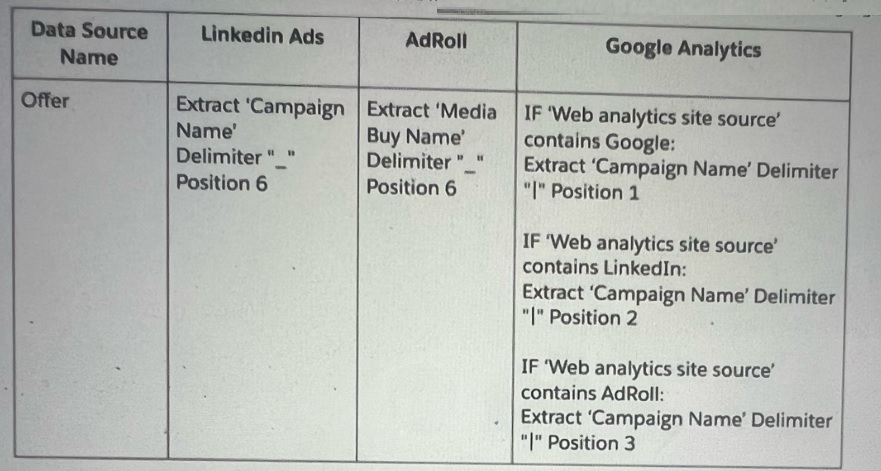At ValidExamDumps, we consistently monitor updates to the Salesforce Marketing-Cloud-Intelligence exam questions by Salesforce. Whenever our team identifies changes in the exam questions,exam objectives, exam focus areas or in exam requirements, We immediately update our exam questions for both PDF and online practice exams. This commitment ensures our customers always have access to the most current and accurate questions. By preparing with these actual questions, our customers can successfully pass the Salesforce Marketing Cloud Intelligence Accredited Professional exam on their first attempt without needing additional materials or study guides.
Other certification materials providers often include outdated or removed questions by Salesforce in their Salesforce Marketing-Cloud-Intelligence exam. These outdated questions lead to customers failing their Salesforce Marketing Cloud Intelligence Accredited Professional exam. In contrast, we ensure our questions bank includes only precise and up-to-date questions, guaranteeing their presence in your actual exam. Our main priority is your success in the Salesforce Marketing-Cloud-Intelligence exam, not profiting from selling obsolete exam questions in PDF or Online Practice Test.
An implementation engineer has been provided with 4 different source files: 03m 48s
1. Twitter Ads ~
2. Creative Classification
3. Placement Classification
4, Campaign Category Classification
The main source is Twitter Ads (which includes various fields and KPIs), and the rest are classification files that connect to Twitter Ads and enrich different fields within it.
The connections between the files are described as follows:
1st Party Creative Classification
File structure/headers:

Creative ID --- links back to Creative Key (Twitter Ads)
1st Party Placement Classification by
File structure/headers:

A)

B)

C)

D)

In Salesforce Marketing Cloud Intelligence, connections between source files and classification files are established through common keys that link data records. For this scenario:
The '1st Party Creative Classification' file has a 'Creative ID' field which corresponds to the 'Creative Key' in the 'Twitter Ads' data. This link enables enrichment of Twitter Ads data with creative classification details.
The '1st Party Placement Classification' file will contain a 'Placement ID' that connects to a corresponding field in the 'Twitter Ads' data, enabling the enrichment of placement classification details.
Option A appears to accurately depict this setup where data streams for 'Creative Classification' and 'Placement Classification' are connected to the 'Twitter Ads' data stream using the 'Creative ID' and 'Placement ID', respectively. This structure allows for the enhancement of the main Twitter Ads data with additional classification information.
A client has integrated data from Facebook Ads. Twitter ads, and Google ads in marketing Cloud intelligence. For each data source, the source, the data follows a naming convensions as ...
Facebook Ads Naming Convention - Campaign Name:
CampID_CampName#Market_Object#object#targetAge_TargetGender
Twitter Ads Naming Convention- Media Buy Name
MarketTargeAgeObjectiveOrderID
Google ads Naming Convention-Media Buy Name:
Buying_type_Market_Objective
The client wants to harmonize their data on the common fields between these two platforms (i.e. Market and Objective) using the Harmonization Center. Given the above information, which statement is correct regarding the ability to implement this request?
wet Me - Given the above information, which statement i 's Correct regarding the ability to implement this request?
Despite the different naming conventions, harmonization is possible using patterns in the Harmonization Center. By extracting the 'Market' and 'Objective' components from the naming conventions of each platform, three separate patterns would be created to map these common fields consistently across the data from Facebook Ads, Twitter Ads, and Google Ads.
A client wants to integrate their data within Marketing Cloud Intelligence to optimize their marketing insights and cross-channel marketing activity analysis. Below are details regarding the different data sources and the number of data streams required for each source.

When harmonizing the Objective field from within the data stream mapping, which advantage is gained?
By harmonizing the Objective field within data stream mapping, an organization can benefit from:
Ease of Maintenance: Harmonization allows for consistent naming conventions across different data sources and streams. This means when business logic or naming conventions change, updates can be made in one place and consistently applied across all data streams. It also reduces the complexity of managing multiple streams and ensures data consistency, which is vital for accurate reporting and analysis.
An implementation engineer is requested to extract the first three-letter segment of the Campaign Name values.
For example:
Campaign Name: AFD@Mulop-1290
Desired outcome: AFD
Other examples:

Which formula will return the desired values?
The EXTRACT function is used to split a string based on a delimiter and return the segment at the specified position. The campaign names are structured with the segment of interest followed by an '@' sign. Therefore, the formula needs to extract the segment before the '@'.
The correct formula is: EXTRACT(csv['campaign_name']; '@', 1). This will take the 'campaign_name' field, split it at the '@' sign, and return the first segment (position 1), which is the three-letter code that is required. The other options are incorrect because they do not properly specify the delimiter and the segment position in the way needed to achieve the desired outcome.
An Implementation engineer is requested to create a new harmonization field 'Offer' and apply the following logic:

The implementation engineer to use the Harmonization Center. Which of the below actions can help implement the new dimension 'Offer?
To implement the new harmonization field 'Offer', the implementation engineer would create two separate harmonization patterns for LinkedIn and AdRoll sources, extracting the 'Campaign Name' using the specified delimiter and position. Then, within Google Analytics' mapping, a custom attribute for the 'Campaign' would be created to apply the formula logic based on the source. This allows for the harmonization of campaign data across different platforms, ensuring consistency in the reporting and analysis within Marketing Cloud Intelligence. The total patterns required would be three, one for each data source involved.